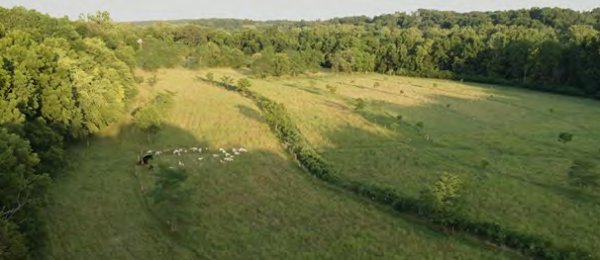AgEBB-MU CAFNR Extension
Green Horizons
Volume 25, Number 1
Winter 2021
NRCS - Agroforestry Spotlight
Silvopasture in Southwest Missouri
Joe Alley, NRCS State Forester
Robert Marsh has been managing livestock for over thirty years on his farm in southwest Missouri. He began experimenting early on with tree crops and silvopasture as ways to improve productivity and sustainability, and his current silvopasture system encompasses a sixteen-acre creek bottom field. Silvopasture is an agroforestry practice that combines livestock, forages, and woody plants on the same acreage. Katahdin sheep are Robert's primary market livestock, but he also raises a few steers each year for beef to share with friends and family.
Robert's approach to silvopasture is a little different than the "poster-child" design where trees are evenly spaced across a pasture. Robert wanted to maintain more flexibility for utilizing his land and settled on establishing trees in widely spaced rows. The rows are one-hundred feet apart with trees spaced twenty to thirty feet apart within the rows. In the short term, shade is relatively limited with this design. However, as the trees mature, each pasture will have a mix of shaded and full-sun zones that will promote diversity in forage type and production and encourage improved grazing distribution. Additionally, the wide spacing provides other management options, such as haying, that would not be as practical with grid-spaced trees.
 |
Photo credit: Tiny Attic Productions |
The long narrow pastures in Robert's design are defined by electric fencing running along each tree row. The fencing provides three purposes. First, the fence defines the side boundaries for each pasture. Second, each one-hundred-foot-wide pasture can be easily subdivided into smaller paddocks by running temporary electric fencing between the fences in the boundary rows. Third, the fence provides for a simple method of protecting the trees from browsing. At each tree, a loop of wire is connected to the electric fence and encircles the tree, keeping livestock at bay. This "two-birds-with-one-stone" approach is a common theme for most things on Robert's farm and is a big key to his success.
Robert has experimented with several types of trees but the primary species in his silvopasture are thornless honeylocust and pecan. The pecans are a recent addition, bringing nut production to the enterprise in the near future. Pecans produce a relatively light shade which is an important characteristic for silvopastures. Thornless honeylocust provides multiple benefits and is very well suited to silvopasture systems. These trees provide a light shade that benefits livestock while having little impact on forage production. In fact, Robert notes that during a drought, grass remains green under honeylocust while drying up in the direct sun. In addition to beneficial shade, the thornless honeylocust that Robert has planted are a variety known for their pod production. The pods have a high sugar content and are consumed by livestock, providing an additional source of forage. Honeylocust is also a legume and adds nitrogen to the soil. This benefits forage production as well as overall soil heath. Note that while the planted trees are thornless, the seeds from them may or may not produce thornless seedlings. However, any seedlings that germinate are also a tasty forage for the sheep and cattle.
Robert recently added a third woody component to his silvopasture, the shrub false indigo (Amorpha fruticose). Through his research, Robert learned that this native shrub provides excellent forage qualities and readily resprouts. It is also a legume, and like honeylocust will add nitrogen to the soil and benefit soil health. He established the false indigo in double rows in very narrow paddocks (fourteen-feet wide). One side of the paddock is located along an existing tree row and thus incorporates honeylocust, pecan, and false indigo in the same paddock. This is design is currently in the experimental stage and is limited to one pasture. However, Robert plans to add more false indigo paddocks if this system is successful. In addition to providing more forage, multiple rows of false indigo would slow flood flows when the local river jumps its banks.
Robert Marsh has created a diverse, productive, and sustainable farm using practical and well thought out techniques. His operation is a shining example of how silvopasture can be tailored to fit multiple objectives while maintaining flexibility. I hope learning about Robert's approach will inspire some of you to make silvopasture work for you. Contact your local NRCS office for additional assistance in planning silvopasture and other agroforestry practices.
NRCS Service Center Locator: https://offices.sc.egov.usda.gov/locator/app?agency=nrcs.
